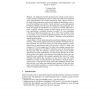Free Online Productivity Tools
i2Speak
i2Symbol
i2OCR
iTex2Img
iWeb2Print
iWeb2Shot
i2Type
iPdf2Split
iPdf2Merge
i2Bopomofo
i2Arabic
i2Style
i2Image
i2PDF
iLatex2Rtf
Sci2ools
113
Voted
CHARME
2005
Springer
2005
Springer
Regular Vacuity
The application of model-checking tools to complex systems involves a nontrivial step of modelling the system by a finite-state model and a translation of the desired properties into a formal specification. While a positive answer of the model checker guarantees that the model satisfies the specification, correctness of the modelling is not checked. Vacuity detection is a successful approach for finding modelling errors that cause the satisfaction of the specification to be trivial. For example, the specification “every request is eventually followed by a grant” is satisfied vacuously in models in which requests are never sent. In general, a specification ϕ is satisfied vacuously in a model M if ϕ has a subformula ψ that does not affect the satisfaction of ϕ in M, where “does not affect” means we can replace ψ by a universally quantified proposition. Previous works focus on temporal logics such as LTL, CTL, and CTL∗ , and reduce vacuity detection to standard m...
CHARME 2005 | Hardware | Regular | Regular Layer | Vacuity Detection |
| Added | 26 Jun 2010 |
| Updated | 26 Jun 2010 |
| Type | Conference |
| Year | 2005 |
| Where | CHARME |
| Authors | Doron Bustan, Alon Flaisher, Orna Grumberg, Orna Kupferman, Moshe Y. Vardi |
Comments (0)

